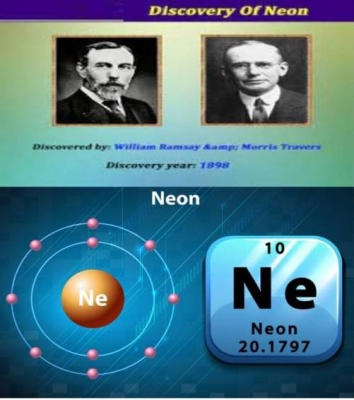
Two British chemists, Sir William Ramsay and Morris W. Travers discovered neon in 1898. Ramsay chilled a sample of air until it became a liquid, and he then heated this liquid to capture the gases that boiled off. Over a period of six weeks, Ramsay and Travers isolated the remaining gases in order of abundance; nitrogen, oxygen, and argon were already identified by then.
First, krypton was discovered, but once it was removed, they were left with a gas that produced brilliant red light under spectroscopic discharge. This gas was neon, and it was given its name by Ramsay’s son. The term neon comes from the Greek word novum, which means new.
Neon is the fifth most abundant element in the universe after hydrogen, helium, oxygen, and carbon. It is a noble gas with the atomic number 10. Under standard conditions, it has two third density of air and is colourless, odourless, inert, and monatomic. Large volumes of neon are formed during the alpha capture fusion process that occurs in stars. Neon is also used in lighting, popularly called the ‘neon lights’.
Neon is rarely found on inner terrestrial planets like Mercury, Venus, Earth and Mars because of its highly volatile nature. It is also incapable of forming compounds that can become solids. As neon is lighter than air, it escapes from the Earth’s atmosphere.
Picture Credit : Google




